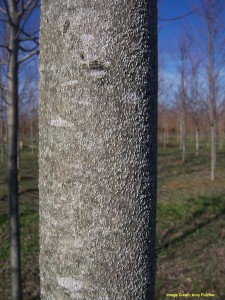Japanese maple scale is a new pest in Tennessee and surrounding states. It infests many more plant species than just Japanese maple. The insect’s small size and ability to blend in naturally with tree bark makes it challenging to detect until populations are high and it has infested large landscape and neighborhoods.
Japanese maple scale (JMS) is a small, oystershell-shaped, armored scale (photo on left). The waxy coating over the body is white, but the female, eggs and crawlers (the immature stage) are lavender in color. Scales are most commonly found on bark but can be found on leaves.
JMS life cycle isn’t completely understood. The insect overwinters on trunks and branches as a small but visible immature scale that matures in spring. Females lay about 25 eggs under their body. Eggs are estimated to develop in April and May, with egg hatch and crawler emergence likely to occur in mid-May in central Tennessee. Crawler hatch coincides with bloom of Syringa reticulata ‘Ivory Silk’ and Hydrangea quercifolia. JMS has two generations a year, a second egg hatch begins around August 1. JMS has extended crawler hatch, which causes the first and second generations to overlap.
JMS has an extremely wide host range that includes Acer, Amelanchier, Camellia, Carpinus, Cercis, Cladrastis, Cornus, Cotoneaster, Euonymus, Fraxinus, Gledistia, Ilex, Itea, Ligustrum, Magnolia, Malus, Prunus, Pyracantha, Pyrus, Salix, Stewartia, Styrax, Syringa, Tilia, Ulmus, Zelkova and others. JMS has been identified along the East Coast of the U.S., Virginia, Kentucky and Tennessee.
The small, white adults are difficult to see and often blend in with light-colored bark or lenticels. Focus at the base of the plant near the soil line to approximately 8 inches high. On standard-form trees, look on the trunk and scaffold branches, in particular at the branch collar. JMS is easier to see in the dormant season when foliage is not hindering the view and the waxy coating appears brighter. JMS is often hidden within the protected interior of dense plants.
The protective waxy coating over the crawlers limits the effectiveness of contact sprays. JMS is especially difficult to control in Ilex and other heavily sheared plants with a dense canopy. A contact insecticide spray must effectively penetrate the canopy to control pest.
Thorough applications of horticultural or superior oil during the dormant period in late winter have been successful. Insecticide sprays should be used to target each flush of crawlers during the spring and summer. Recommended insecticides include the insect growth regulators pyriproxyfen (Distance) or buprofezin (Talus 40SC) and the neonicotinoid clothianidin (Arena 50 WDG). Horticultural oil (at 0.5 to 1 percent) may be tank-mixed with Distance or Talus 40SC for improved control.


 Posted in
Posted in 
